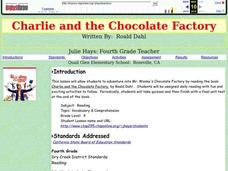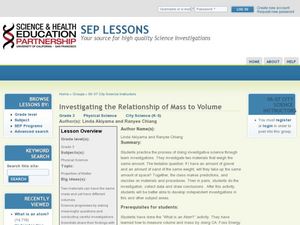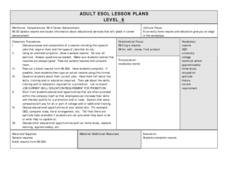Curated OER
Charlie and the Chocolate Factory
Fourth graders read and take quizzes over the book, Charlie and the Chocolate Factory.
Curated OER
Garden Grid
Basically, your class reads about different garden plants from an included handout and seed packets that you provide, and then uses a grid to plan out where to place the plants. They can practice counting with the seeds, grouping,...
Curated OER
Energy Sources
Students identify natural resources and describe the difference between renewable and non-renewable resources. They also identify the disadvantages and advantages of the resources.
Curated OER
Do You Know Bamboo?
Students understand the properties of Bamboo and what it can be used for. For this bamboo lesson, students with bamboo and compare and contrast to wood. Students share their findings.
Curated OER
Draw an Alien in Natural Habitat
Students apply prior knowledge of living things, structures of living things and how living things sense and respond to their environment. In this habitat lesson, students review the basic needs of organisms to survive. Students create...
Curated OER
The Three Branches of Government
Sixth graders discover details about the 3 branches of government. In this primary source analysis instructional activity, 6th graders examine documents and images from the Library of Congress to investigate the structure of the U.S....
Curated OER
The Earth around Us: Air, Water & Soil
Young scholars recognize that science is everywhere. In this scientific method lesson, students experiment with height and record their experiment using the scientific method. Young scholars must identify each step of...
Curated OER
Investigating the Relationship of Mass to Volume
Third graders explore the relationship of mass to volume. In this physical science lesson, 3rd graders participate in an investigation with a several materials and measure the mass and volume using scientific tools. Students discuss and...
Curated OER
Building A Resume
After a brief lecture on the purpose and components of a resume, students fill in a blank reusme according to the type of job they would like to apply for. They compare their resume to the job they currently hold. Students look for...
Curated OER
Rolling Balls: Mass and Kinetic Energy
Learners identify the relationship between kinetic energy, mass, and velocity. Then they explain and graph the relationship between kinetic energy and mass. Students also predict the impact of objects of different mass and velocity on...
Curated OER
ADDING ON THE NUMBER LINE ACCENTUATING THE NEGATIVE
Seventh graders solve problems involving addition of positive and accentuating negative integers. In this adding real numbers instructional activity, 7th graders draw a number line on chart paper, complete a working sheet and use the...
Curated OER
Perception and the Brain
Students experience how the brain adapts over time to changes in what they perceive. In this human perception lesson, students wear special prism goggles that initially disorient the user. Over time, the student is able to adjust to the...
Curated OER
Designing a Study
Students explore features to consider when designing a scientific study. In this science research lesson plan, students examine different methods of data collection and consider which method would be appropriate for determining how many...
Curated OER
Crime Time
Young scholars examine fundamentals of American criminal justice by analyzing each step of the criminal process. They follow the process of a well-known or publicized criminal case in The New York Times, and keep a journal of its...
Curated OER
Effigy Mound Activity
Students research effigy mounds of Native people in Wisconsin. They create large models of effigy mounds in a given area based on factual information from their studies and research.
Curated OER
Civilizations of the Ancient Near East
Sixth graders investigate ancient civilizations by creating a research project. In this world history lesson, 6th graders investigate historic civilizations developed close to important rivers of the near East. Students...
Curated OER
Ethan Frome
Students can earn up to 50 points in Section I "C" Level. They can earn up to 10 points in Section "B" where students can complete only one activity. Students can earn a maximum of 20 points in Section "A" activities.
Curated OER
Modeling the Change of Seasons
Learners evaluate data to determine changes in length of day. They model the revolution of Earth around the sun to show changes in length of day and sun angle and illustrate how the sun angle affects the change of season.
Curated OER
Pythagoreum Theorem
Students practice assessing how to apply the formulas for the area of parallelograms and triangles. They recount the contributions of Pythagoras and apply the theories of the Pythagorean theorem in a group project to calculate the...
Curated OER
Invent on the Spot
The best inventions come from a problem that needs to be solved! Given a container with holes in...
Curated OER
Cleaning Water: How Filters Work
Students construct their own water filter to obtain clean water. In this filtration lesson, students produce tainted water in order to properly filter it with filtration devices made in class.
Curated OER
Sheep Heart Dissection
Fifth graders examine a sheep heart. In this biology lesson, 5th graders dissect a sheep heart to identify the parts of a heart including the aorta, valve, septum, and ventricle.
Curated OER
Living or Non-Living
Young scholars examine living and non-living things. In this life science lesson, students are given a group of objects and discuss if they are living or non-living. Young scholars identify and list characteristics of living things.
Curated OER
Love in the Time of Cholera
Young scholars examine causes and treatment options for cholera. In this biology lesson, students model the osmotic basis of cholera using dialysis tubes. Young scholars propose treatments for hypothetical patient.























